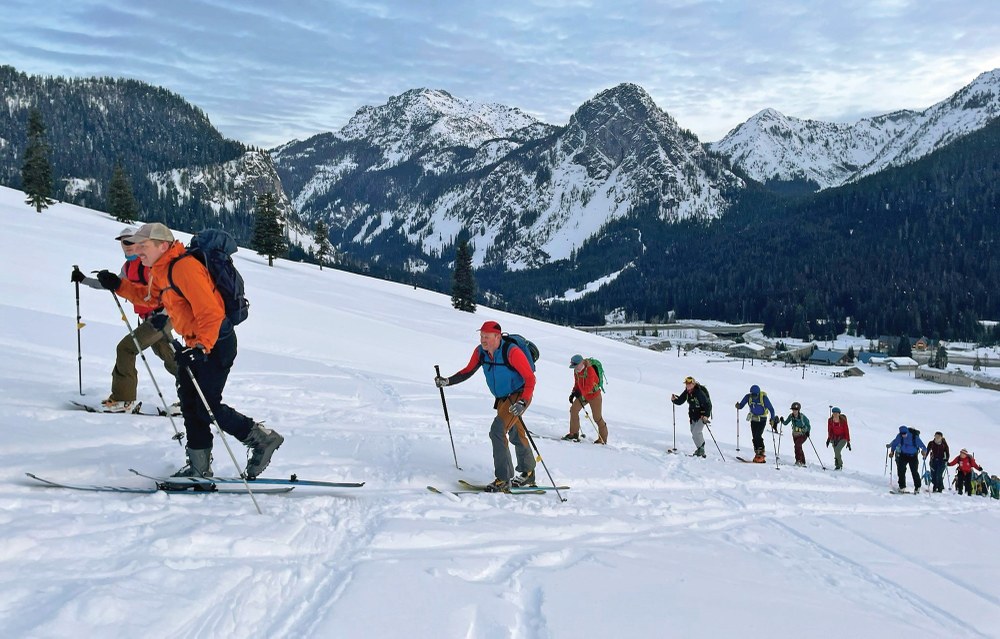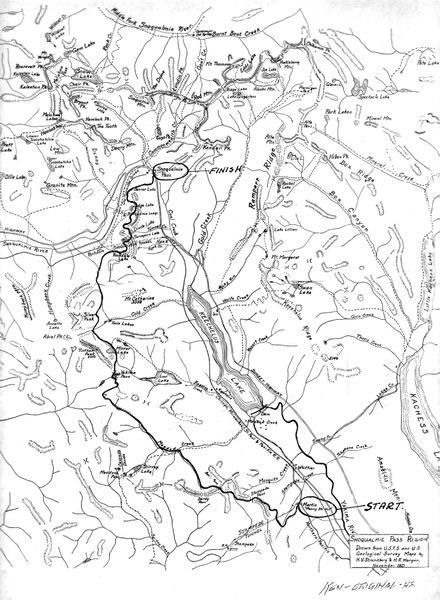
Headlamps pierced the 4am darkness of a hopeful winter morning as Nigel Steere welcomed a jovial group of ski fanatics eager for a grueling day of touring. This wasn’t just any backcountry tour. The eleven teams, strapped to their skis and braving the pre-dawn cold, were making history as the first Patrol Race contestants since the infamous event ended in 1941.
Despite a few hiccups – including a mechanically terminal snowmobile and a Sno-Cat nearly left permanently marooned during a rescue excursion – the race was a success and seven of the eleven teams crossed the finish line. Set in motion by a few fliers and word-of-mouth, a tradition that had rested undisturbed for 73 years in forests and valleys along the Cascade crest was finally rekindled.
The origins of the Patrol Race
Led entirely by Mountaineers volunteers, the Patrol Race is the longest continuing ski race in the Northwest. Traversing a punishing twenty miles, the course navigates challenging terrain, including forests, ravines, creeks, cirques, lakes, and seven passes. The route – much of which spans the Pacific Crest Trail – starts at the bottom of the Snoqualmie Pass Ski Area’s Little Thunder Chair and ends at Meany Lodge. Teams consist of three racers, and participants must complete the race within one minute of each other. Skiers finish with buckling knees, screaming quads, and the sound of ringing cowbells as they ski down the rugged, steep, and infamous “Lane” to the finish line where they are greeted by smiling faces and beverages of their choosing.
 Racers sporting leis at the 2021 race. Photo by Rick Meade.
Racers sporting leis at the 2021 race. Photo by Rick Meade.
The Patrol Race is modeled after European military ski races whereby groups of skiers would execute a task – like setting up a piece of military equipment – on skis. This style of race emulates the traditional use of skis, when the equipment was used for moving from one point to another rather than skinning for steep powder or aggressive terrain.
At the time of the race’s origins, skiing was the new best thing to do in the mountains, and both Snoqualmie Lodge and the recently constructed Meany Ski Hut were popular destinations for Mountaineers members who were inspired by their European counterparts to explore what the snowy Cascades had to offer. As Mountaineers scouted new winter recreation routes, orange tin shingles were placed high on trees to demarcate paths, one of which included a route between the Snoqualmie Lodge and the Meany Ski Hut. This route was challenging enough that the original scouting party got temporarily lost and spent an unplanned night in the snow.
In 1930, six men and one woman were the first to continuously ski the full length of the trail. A few days later, the first official Patrol Race was held, and the winning team crossed the finish line in seven and a half hours.
Reviving history, breaking records
The rise of ski resorts and “easier” ways of skiing led to the end of the Patrol Race just before WWII; however, what was once the Patrol Race’s downfall became its saving grace as budding Mountaineer backcountry enthusiasts of the modern era were allured by the opportunity to slog their way through the backcountry once again. Recognizing this growing enthusiasm for the older ways, Nigel Steere, with the help of Mountaineers friends and Meany Lodge volunteers, re-ignited the Patrol Race.
At the revival race in 2014, the winning team crossed the finish line in 7 hours and 9 minutes, over two and a half hours slower than the record set by 1936 winners Wolf Bauer, Paul Shorrock, and Hans-Otto Giese who used wooden skis and wax. Despite modern advancements in gear, the 1936 record held steadfast until 2017 when team “Wet and Scrappy,” comprised of Lowell Skoog, Seth Davis, and Aaron Ostrovsky, skied across the finish line in 4 hours, 19 minutes, and 23 seconds. The current record, set on a slightly modified route (about two miles longer than the original), was made in 2019 by Allan Taylor, Ethan Linck, and Todd Kilcup (“Fastest Known Team”), who crossed in 4 hours, 35 minutes, and 46 seconds, despite losing a pole to a tree well midway.
 The original race route (ran in reverse some years) from the 1930s. Map courtesy of Nigel Steere.
The original race route (ran in reverse some years) from the 1930s. Map courtesy of Nigel Steere.
A great effort has been made to follow the historical track, with a few exceptions only to avoid groomed roads that weren't there in the 1930s. At several points along the way, the watchful eye can still see rusted metal tags nailed high in the trees that once denoted the full length of the pilgrimage. Race rules are also largely unchanged, adhering to the original intent: all three team members must stay together for the entire course, with the modification that each member must carry standard avalanche-rescue equipment - a shovel, probe, and beacon. This new list forgoes historically required safety items like “three new candles.”
Many hands make lively work
Legend has it that there were often more people organizing the race than skiing it. Sometimes this still feels true. The many volunteers who come every year are what make up the spirit and fabric of the Patrol Race.
Leading up to race day in early March, seasoned volunteers scout the route status and conditions. Snowmobiles are repaired, radio equipment is updated, and volunteers are organized into teams: trail breakers and sweepers, starters, checkpoint 1 crew, checkpoint 2 crew, finish crew, and Meany Lodge food, transportation, and prep.
The day before the race, trail break crews set the track. (Legend also has it that Fred Beckey was on one of those teams because he was too young to officially compete). If it snows overnight, trail breakers return before dawn to reset the skin track. Pre-dawn, the start crew and racers gather at the starting line to set up. Volunteers answer course questions, take photos, and check in racers with team names like “Legs Miserables,” “Are We There Yet?,” and “Where’s the Chairlift.”
 2024 Racers enjoying a brief pause mid-course near Yakama Pass. Photo by Rick Meade.
2024 Racers enjoying a brief pause mid-course near Yakama Pass. Photo by Rick Meade.
The different divisions set out between 6-8am, after completing safety checks and other pre-dawn rituals (like singing the national anthem) that motivate skiers to march through the woods for 5-10 hours. Sweep teams, mostly led by Cascade Backcountry Ski Patrollers, work tirelessly throughout the day to ensure that all teams are accounted for and, if needed, able to exit the course safely. Race checkpoints along the way provide race whimsy such as ax throwing or “ski archery” while teammates attend to blisters, rip skins, and repair gear with creative tools like duct tape.
At the finish line, volunteers wait for all teams to finish, ring cowbells for encouragement, take finish line photos, document finish times, and distribute beverages. Teams are then treated to hot soup by the fire pit, grilled cheese sandwiches, and an awards ceremony on the “snow-podium.”
Racers can pre-book a stay at Meany Lodge, the oldest operating ski area in Washington, or finish the journey to their car at Crystal Springs Sno-Park. Either way, the return to reality involves another few miles on skis or a tow behind Meany’s 60-year-old snowcat.
Participate in the 2025 Patrol Race
What began as a race involving 12 contestants now welcomes close to a hundred each year. The revival of the Patrol Race has made a tremendous tradition of old-school-style ski racing in the Northwest, with an enthusiastic group of teams and an even more enthusiastic group of volunteers spanning the entire route. The 2025 Patrol Race will take place on Saturday, March 15. For more information, visit: mountaineers.org/Mountaineers-Patrol-Race.
This article originally appeared in our winter 2025 issue of Mountaineer magazine. To view the original article in magazine form and read more stories from our publication, visit our magazine archive.
 Tracy Fuentes
Tracy Fuentes
 Pat Boyle
Pat Boyle